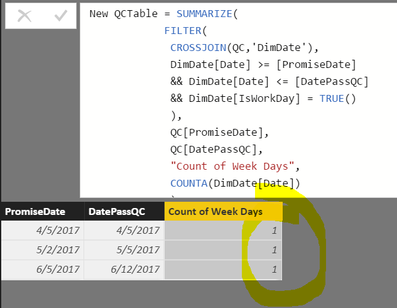FabCon is coming to Atlanta
Join us at FabCon Atlanta from March 16 - 20, 2026, for the ultimate Fabric, Power BI, AI and SQL community-led event. Save $200 with code FABCOMM.
Register now!- Power BI forums
- Get Help with Power BI
- Desktop
- Service
- Report Server
- Power Query
- Mobile Apps
- Developer
- DAX Commands and Tips
- Custom Visuals Development Discussion
- Health and Life Sciences
- Power BI Spanish forums
- Translated Spanish Desktop
- Training and Consulting
- Instructor Led Training
- Dashboard in a Day for Women, by Women
- Galleries
- Data Stories Gallery
- Themes Gallery
- Contests Gallery
- Quick Measures Gallery
- Visual Calculations Gallery
- Notebook Gallery
- Translytical Task Flow Gallery
- TMDL Gallery
- R Script Showcase
- Webinars and Video Gallery
- Ideas
- Custom Visuals Ideas (read-only)
- Issues
- Issues
- Events
- Upcoming Events
Calling all Data Engineers! Fabric Data Engineer (Exam DP-700) live sessions are back! Starting October 16th. Sign up.
- Power BI forums
- Forums
- Get Help with Power BI
- Desktop
- Re: Number of days between two dates, but only cou...
- Subscribe to RSS Feed
- Mark Topic as New
- Mark Topic as Read
- Float this Topic for Current User
- Bookmark
- Subscribe
- Printer Friendly Page
- Mark as New
- Bookmark
- Subscribe
- Mute
- Subscribe to RSS Feed
- Permalink
- Report Inappropriate Content
Number of days between two dates, but only counting work/business days...
Sample data: https://www.dropbox.com/sh/lzgqonrufze6mql/AABDGjIHOvu7iraqXeqKTmA9a?dl=0
We have a "PromiseDate" which is when we tell the customer it will be ready. The product needs to be passed quality control (DatePassedQC) at least one work day prior to the PromiseDate. If the DatePassedQC is on or after the PromiseDate, then the order is late by the number of workdays between the two dates.
So in short, I need to calculate the number of workdays between the PromiseDate and the DatePassedQC date, but also keep in mind that sometimes the DatePassedQC date will be before the PromiseDate and other times it will be after the PromiseDate. You should be able to access the sample files, which represent the date tables I'm working with.
Thank you for your help.
Solved! Go to Solution.
- Mark as New
- Bookmark
- Subscribe
- Mute
- Subscribe to RSS Feed
- Permalink
- Report Inappropriate Content
Hi @iDataDrew
I created the following Calculated Table using your data. If it's close, it may only need a slight tweek around the < and > operators on the FILTER
New QCTable = SUMMARIZE(
FILTER(
CROSSJOIN(QCTable,'DateTable'),
[Date] >= [PromiseDate]
&& [Date] <= [DatePassQC]
&& [IsWorkDay] = true()
),
[PromiseDate],
QCTable[DatePassQC],
"Count of Week Days",
COUNTA('DateTable'[Date])
)Which gave me this
- Mark as New
- Bookmark
- Subscribe
- Mute
- Subscribe to RSS Feed
- Permalink
- Report Inappropriate Content
Hi @iDataDrew
I created the following Calculated Table using your data. If it's close, it may only need a slight tweek around the < and > operators on the FILTER
New QCTable = SUMMARIZE(
FILTER(
CROSSJOIN(QCTable,'DateTable'),
[Date] >= [PromiseDate]
&& [Date] <= [DatePassQC]
&& [IsWorkDay] = true()
),
[PromiseDate],
QCTable[DatePassQC],
"Count of Week Days",
COUNTA('DateTable'[Date])
)Which gave me this
- Mark as New
- Bookmark
- Subscribe
- Mute
- Subscribe to RSS Feed
- Permalink
- Report Inappropriate Content
@v-huizhn-msft and @Phil_Seamark I figured it out. @Phil_Seamark's solution ended up working. For some reason, it didn't work when I had a relationship between the QC table and the DimDate table. When I deleted that relationship, then the New QCTable worked. Any ideas on why that would be? Either way, thank you for the solution!
- Mark as New
- Bookmark
- Subscribe
- Mute
- Subscribe to RSS Feed
- Permalink
- Report Inappropriate Content
Thank you for the quick response @Phil_Seamark. See screenshot below. I used the same calculated table, but did not get the same result. Have any ideas on why that might be? Thank you.
- Mark as New
- Bookmark
- Subscribe
- Mute
- Subscribe to RSS Feed
- Permalink
- Report Inappropriate Content
Hi @iDataDrew,
After tested, you it return the same result like @Phil_Seamark. Please confirm you have created a new table(by click "New Table" under Modeling on home page) rether than a calculated column?
Best Regards,
Angelia
Helpful resources

FabCon Global Hackathon
Join the Fabric FabCon Global Hackathon—running virtually through Nov 3. Open to all skill levels. $10,000 in prizes!

Power BI Monthly Update - October 2025
Check out the October 2025 Power BI update to learn about new features.




